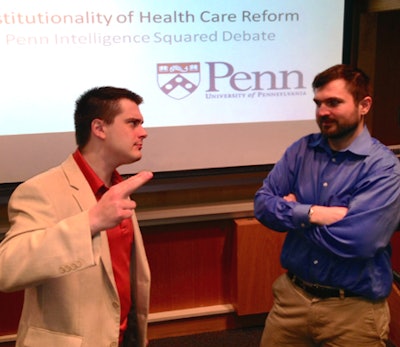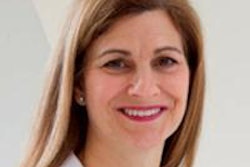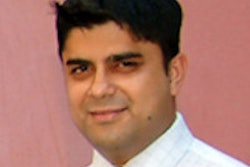
There's no better way to put an audience of residents to sleep than submit them to a traditional didactic lecture. But offer the same material to them as a lively debate and they'll sit up and take notice, say researchers from Pennsylvania, who are using the debate format as a key part of teaching.
At the University of Pennsylvania, Dr. Saurabh Jha and a colleague decided they needed to improve the learning experience in their economics and policy course for residents. They turned to the debate format as a way to do it (Academic Radiology, April 1, 2013).
"Two of us ... had done a degree at Wharton [School] that involved a lot of economics, so we brought about the curriculum, and when we started the didactic lectures, we saw the 'yawn-o-meter' go up -- it was off the scale," Jha said.
That's when they decided to implement the debates -- the first on the constitutionality of the Patient Protection and Affordable Care Act (PPACA), aka "Obamacare," well before the Supreme Court ruled that the massive healthcare reform law was constitutional.
"We had two fourth-year residents, and they were fantastic," Jha said. "They were factual, they were theatrical, they'd done their homework, and what was important was not just what the debate came out with, but the discussion thereafter on various topics like the role of the government in healthcare and the role of the free market in healthcare -- issues that don't have a clear-cut answer."

The residents in the room also were engaged, and there was a lot of cross-questioning, Jha said. "With another resident debating, the fellow residents are much more likely to ask questions," he said. "And they don't fear being oppositional."
Residents who have been assigned to a debate develop a kind of ownership of the subject, "learning it to a far greater depth than might have been possible from a didactic lecture," Jha wrote. Residents who are watching the debate also are animated by the topic, especially because their friends and colleagues are the presenters.
Staging debates
The debates are held in front of an audience comprised mainly of other residents, and the roles of protagonist and antagonist are assigned randomly, sometimes contrary to the residents' personal opinions, Jha wrote.
"I think that's a good mental exercise," he said.
About an hour is plenty of time for debate, including discussion time at the end, he said. First, the moderator summarizes the issues surrounding the motion. Each debator spends 10 minutes presenting the core of their argument, then five minutes for a rebuttal, followed by an additional four minutes answering targeted questions from the moderator.
Finally, the audience votes for the presenter with the most convincing argument, and the moderator highlights the strengths of each position.
"The moderator plays a key role in not only setting the rules of the debate, but also in the educational framework for the debate," Jha wrote. "Knowledge of the subject matter -- the economic, legal, and ethical precepts -- is crucial to successful moderation."
With the constitutionality of the PPACA having been decided definitively, plenty of other topics are well-suited to the debate format, he said. The key requirement being that there be valid arguments on each side. Debates might highlight an economic principle, or a legal or ethical dilemma based on opposing values. In his Academic Radiology article, Jha cited several additional topics, including the following:
- Economic expediency versus political freedom in the mandate to purchase healthcare insurance
- Rationing of healthcare: Should mammography be routinely offered to women ages 40-49 years?
- Economy of scale, protectionism, and quality: Should technologists interpret a wider range of imaging studies?
- Quality versus resource utilization: Should radiologists communicate results directly to patients?
Two of Jha's residents will demonstrate their skills at the American College of Radiology's upcoming Annual Meeting and Chapter Leadership Conference (AMCLC) to be held in Washington, DC, on May 4-8. Offered as a "Point/Counterpoint" session on May 5, the discussion will feature residents and fellows Dr. Neil Lall versus Dr. Matt Hawkins debating fee-for-service healthcare, specifically, whether its demise will end up being good or bad for radiology.
Back at the University of Pennsylvania, debates are typically held and prepared for during the morning conference, which is protected teaching time, Jha said. Here as well, debates are restricted to about an hour, including 15 minutes of argument for each side, some closing comments, and a summation of arguments by the moderator.
The debate forces participants to acknowledge counterpoints, the trade-offs, and the chasm between opposing views that establishes the necessary tension for discussion -- all ingredients to establishing the normative frame for imaging, Jha said.
By debating, radiology residents "are preparing for a world in which physicians have to promote their views in a wider world," Jha said. "I think it's especially true for radiology because of the way it's evolved as a specialty" in which radiologists "have to look after themselves, sometimes with greater government help, sometimes with less."
The value of debating experience is easy enough to imagine in the real world, he said. You might be the lead in a large practice where the local Blue Cross representative doesn't think it's necessary to pay for screening virtual colonoscopy.
In this situation and countless others, radiologists who honed their debating skills as residents might be the ones who make a real difference for patients -- and radiology, Jha said.
Being an effective advocate for imaging means understanding what people on the other side of the issue are saying, rather than just coming out and saying that they're wrong or unscientific, according to Jha.
"Radiologists will have to demonstrate their value at the societal level as well as at the patient level," he wrote. "They may have to persuade a variety of decision-makers, the local congress member, the chief executive officer of the hospital, and the payors, to name but a few."
Being well-prepared means having a command of the basics of economics and health policy that pertain in particular to imaging, he said. It means being articulate and having the fluency that comes with understanding the subject matter.
Most important is learning to provide well-formed counterarguments, a skill that requires understanding the other side's point of view, Jha said.
That way, "I can see where they're coming from, and this is why they're saying what they're saying," he said. "I think this is a better approach than coming out with all guns blazing and accusing one section of the medical fraternity of not knowing what they're talking about. I don't think that's going to help."



















